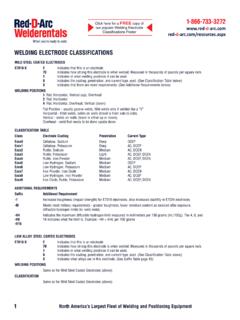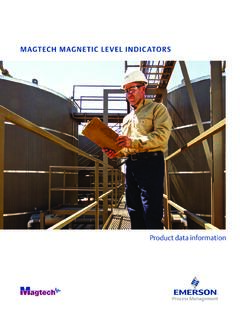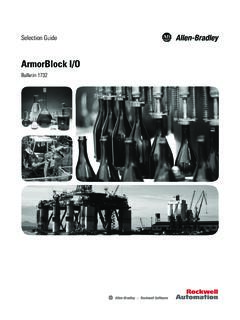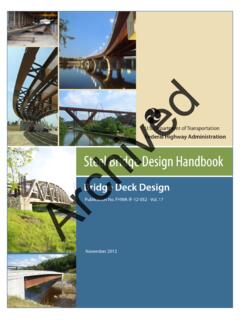Transcription of MATERIAL SAFETY DATA SHEET - ALUMINUM ALLOYS
1 MATERIAL SAFETY DATA SHEET - ALUMINUM ALLOYS . SECTION I: CHEMICAL PRODUCT AND COMPANY IDENTIFICATION. Product Name: ALUMINUM ALLOYS Note: ALUMINUM ALLOYS in their usual solid form and under normal conditions do not present an inhalation, ingestion, or contact health hazard or fire or explosion hazard. Operations such as welding, sawing, brazing, burning, grinding, cutting, abrasive blasting, heat treating, pickling, machining, or similar operations may generate dust, fumes, chips, or machine turnings that may create a health or fire or explosion hazard. This MSDS does not apply to ALUMINUM ALLOYS in powdered forms. Manufacturer's Name: Emergency Phone Number: Wyman-Gordon Company (508) 839-4441. 244 Worcester Street Telephone Number for Information: North Grafton, MA 01536-8001 (508) 839-4441.
2 SECTION 2: COMPOSITION AND INFORMATION ON INGREDIENTS The chemical composition of ALUMINUM ALLOYS will vary by the alloy grade. Approximate weight percentages (WT. %) are shown below. Refer to product specification for exact composition. Alloy Copper Silicon Iron Manganese Magnesium Zinc Chromium Titanium Zirconium Beryllium Vanadium Nickel ALUMINUM Name (Cu) (Si) (Fe) (Mn) (Mg) (Zn) (Cr) (Ti) (Zr) (Be) (V) (Ni) (Al). 2014 - - - - Remainder 2219 - - - Remainder 2618 - - - - - Remainder 6061 - - - - Remainder 6151 - - - - Remainder 7049 - - - - Remainder 7050 - - - Remainder 7075 - - - - Remainder 7175 - - - - Remainder 40E - - - - 91. 201 5 - - - - - - - 94. 206 5 - - - - - - 94. 242 - - - - 90. 354 - - - - - 87. C355 6 - - - - - 92. A356 8 - - - - - 91. A357 8 - - - - 91. 358 8 - - - 90.
3 C612 7 - - - - - 90. PR71A 7 - - - - 91. RR350 5 - - - - - - - 92. OCCUPATIONAL EXPOSURE LIMITS. Ingredient CAS Classified as Carcinogen PEL (2008) TLV (2011). Number (8-Hour TWA) (8-Hour TWA). ALUMINUM (as Al) 7429-90-5 None Found Total Dust 15 mg/m3 mg/m3 (R). Respirable Dust 5 mg/m3. Silicon (as Si) 7440-21-3 None Found Total Dust 15 mg/m3 10 mg/m3. Respirable Dust 5 mg/m3. Magnesium (as 1309-48-4 None Found Total Particulate 15 mg/m3 10 mg/m3 (as oxide fume). Mg). Copper (as Cu) 7440-50-8 None Found Fume (as Cu) mg/m3 Fume mg/m3. Dust & Mist (as Cu) mg/m3 Dust & Mist (as Cu) mg/m3. Iron (as Fe) 7439-89-6 None Found PEL Vacated 1989 Iron Oxide (Fe2O3) mg/m3. (as Fe2O3) 1309-37-1 Oxide Fume 10 mg/m3. Manganese (as 7439-96-5 RTECS contains tumorigenic and/or mg/m3 (Ceiling) mg/m3. Mn) carcinogenic and/or neoplastic data for components in this product Zinc (as Zn) 7440-66-6 None Found Total Dust 15 mg/m3 2 mg/m3 (as ZnO).
4 (as ZnO) 1314-13-2 Respirable Dust 5 mg/m3 Fume 10mg/m3 as ZnO (STEL). Titanium (as Ti) 7440-32-6 None Found None Listed None Listed (as TiO2) 13463-67-7 IARC Group 3 Total Dust 15 mg/m3 10 mg/m3. Beryllium (as Be) 7440-41-7 IARC Group 1 mg/M3 mg/m3. Yes NTP mg/m3 (Ceiling) Beryllium and Compounds, Yes OSHA as Be (2008). Chromium (as Cr) 7440-47-3 IARC Class 3 mg/m3 Cr Metal and Cr III compounds - (as Cr III) IARC Class 3 mg/m3 (as Cr VI) IARC Class 1, Yes NTP ug/m3 Action Level = Water Soluble Cr VI compounds - ug/m Insoluble Cr VI compounds mg/m3. Nickel 7440-02-0 IARC Group 2 mg/m3 mg/m . (as Ni). Elemental Vanadium (as V) 7440-62-2 None Found None Listed None Listed (as V2O5) 1314-62-1 Respirable Dust mg/m Fume & Dust mg/m . (Ceiling). Fume mg/m (Ceiling). Zirconium 7440-67-7 None Found 5 mg/m 5 mg/m.
5 (Zr) 10 mg/m3 STEL. MATERIAL SAFETY DATA SHEET - ALUMINUM ALLOYS . SECTION 3: HAZARDS IDENTIFICATION (See Note in Section 1). Carcinogenicity: IARC, NTP, and OSHA do not list ALUMINUM alloy as a carcinogen. Beryllium contained in some ALUMINUM ALLOYS is classified as carcinogenic by IARC, NTP, and OSHA. Chromium metal contained in some ALUMINUM ALLOYS is classified as carcinogenic by IARC. Hexavalent chromium though not present in the alloy may be formed during welding or other thermal processes and is classified as carcinogenic by NTP. Routes of Entry/Exposure: ALUMINUM ALLOYS in their usual solid form and under normal conditions do not present an inhalation, ingestion, or contact health hazard. Inhalation may occur if dust or fumes are generated. Skin absorption is not likely to occur, but irritation may occur when in contact with skin.
6 Ingestion is not likely to occur. Target Organs: Lungs, eyes and skin. Short-Term (Acute) Effects of Overexposure: Eyes: Dusts or fumes can cause irritation with burning and tearing. Skin: Dusts or fumes can cause irritation with itching. Dermatitis may occur. Inhalation: Dusts or Fumes can cause irritation and dryness of the nose and Ingestion: Diarrhea, black stools, and cramping may occur. throat, coughing, bronchitis, pneumonia, chest pain, and pulmonary edema. Long-Term (Chronic) Effects of Overexposure: No significant adverse health effects found in literature search specific to ALUMINUM ALLOYS . Chronic exposure to certain metals in ALUMINUM ALLOYS may cause non-progressive pulmonary fibrosis or chronic bronchitis when overexposed to elevated dust or fume concentrations. Other symptoms include shortness of breath, cough, chest tightness, and wheezing without impairment Dermatitis and allergic sensitization have been reported.
7 Overexposure to beryllium may cause chronic beryllium disease. The Department of Energy and others, have questioned the adequacy of existing exposure limits fur beryllium in preventing chronic beryllium disease. Conditions Aggravated By Exposure: Persons with sensitive skin or allergies to metals may be aggravated by exposure. Persons with respiratory problems and Wilson's disease may also be aggravated by exposure. Also See TOXICOLOGICAL INFORMATION (Section I I). SECTION 4: FIRST AID MEASURES. Eyes: Immediately flush eyes with plenty of water for at least 15 minutes Skin: Wash contaminated areas with plenty of soap and water for at least 15. holding eyelids apart to ensure flushing of entire eye surface. Seek medical minutes. Remove contaminated clothing and wash before reuse. Seek medical attention after flushing eyes with water.
8 Attention if any irritation or redness occurs. Inhalation: Get person out of contaminated area to fresh air. If breathing has Ingestion: Seek medical attention immediately. Never give anything by stopped, give artificial respiration and seek medical attention immediately. mouth to an unconscious person. Get appropriate in-plant, paramedic, or community medical support after first aid is given. Note to Physicians: Treat symptomatically. SECTION 5: FIRE FIGHTING MEASURES (See Note in Section 1). Auto ignition Temperature: Auto ignition will not occur for solid metal alloy. Dust cloud may be explosive (NFPA 65). Flammable Limits: Not Tested. Extinguishing Media: Do Not Use Water or Halogenated Extinguisher Agents! Dry sodium chloride is most effective for containing particulate fires. Flux (KCI, MgCl2, CaF2) is effective in reducing the oxygen supply of the fire.
9 See NFPA Code No. 65 for more information. Special Fire Fighting Procedures: Wear self-contained breathing apparatus with full face piece operated in positive pressure mode and full turn-out gear. Unusual Fire and Explosion Hazards: No fire or explosion hazard with solid metal ALLOYS . A severe fire hazard may exist when fine turnings or chips are produced and during disposal of scrap containing chips or fines. Dry ALUMINUM alloy powder (NFPA 65) can be ignited by a match or small spark. Toxic metal fumes of ALUMINUM , silicon, magnesium, copper, iron, nickel, zinc, titanium, and beryllium may be emitted. Molten alloy and water can cause an explosion. SECTION 6: ACCIDENTAL RELEASE MEASURES (See Note in Section 1). Should spills of dust occur, use vacuum cleaner rated to clean up explosive dust and equipped with High Efficiency Particulate (HEPA) filters to clean minor spills.
10 Do not sweep or use compressed air to clean up spills. Dispose of spilled MATERIAL in accordance with local, state, and federal regulations. SECTION 7: HANDLING AND STORAGE. Handling Precautions: Avoid generation of dust. Use good housekeeping practices if dusts are formed to prevent accumulation. Use appropriate personal protection. Contact qualified SAFETY and health specialists to review usage and possible exposures. Follow procedures contained in 29 CFR , ALUMINUM Association Bulletin F-l and NFPA 65. Provide grounding and bonding to prevent accumulation of static charges during dust or fume generation (NFPA 65,70,77). Storage Requirements: Store in cool, dry, and well ventilated area away from incompatibles. Protect from physical damage and contact with water. Regulatory Requirements: Follow OSHA, EPA, and DOT requirements.







